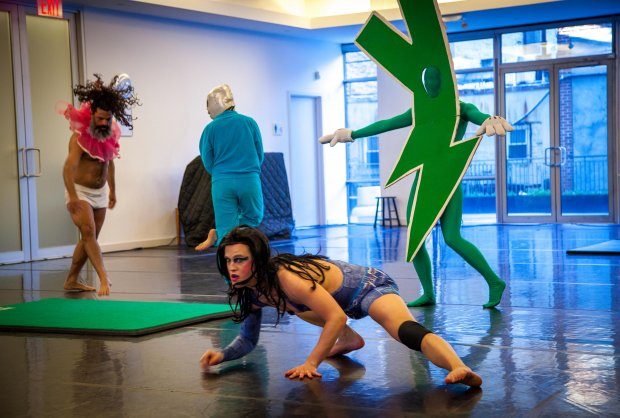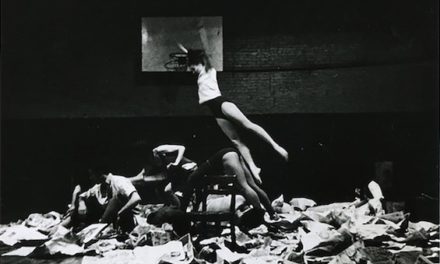The non-Broadway performing arts scene in New York is characterized by a painful lack of funding that almost makes the situation in Europe seem luxurious. In the work of the New York-based Larissa Velez-Jackson and her group “Yackez,” this economic condition becomes an aesthetic that prompts a reconsideration of some contemporary assumptions regarding the relations of artistic production, presentation, consumption, and critique – as well as their residual material.
– “Mourons pour des idées, d’accord, mais de mort lente,” George Brassens
Larissa and Jon Velez-Jackson slowly enter the stage. They are both holding the hands of a bright-green mascot whose form is composed of the letter “Y” and a lightning symbol. The “Y” stands for “Yackez,” their joint ongoing project. The lightning symbol is just there. The married couple, each of which is around 40 years old, enter the space hesitantly, gently. It seems as if they’re trying to provide a secure space for the living symbol of their joint creation. They will soon wake their performative baby-monster, but they intend to do it gently, as good parents do.
The space is empty, unprepared, untidy: unrepresentable. After leaving the Mascot in the center of the space the parents loosely perform the clichéd scene of the child’s-first-day-at-school farewell: look where we are now; look what we’ve created; looks like we’ve made it; and so on, and so on. They then walk slowly to the table. With her back to the stage, Larissa handles a tablet computer unceremoniously, with prosaic, inattentive gestures. Loud, rhythmic, industrial music breaks out, designed and recorded by the Velez-Jacksons themselves. Another masked figure, dressed in a black bodysuit, enters and mimics Larissa as she starts moving to the beat. However, the masked “shadow” is always late and imprecise. It’s a bad, unprofessional shadow. Too human.
Similarly gripped by the music, the green mascot starts to move as other figures, or rather characters, enter the scene: a tall, bearded, shirtless and hairy-bodied non-dancer dressed as a baby; a small-bodied, sexless figure dressed in a tight leotard and masked in the Mexican Lucha Libre style; and, lastly, a highly trained dancer, dressed in drag, wearing a wig, walking on heels. A sense of anarchy rules both stage and bodies. This is the Yackez family, and they run a radical shit-show. This is not meant as a derogatory term, but as a descriptive, almost analytical one. It’s inspired by Larissa Velez-Jackson’s own ongoing and related project, “Star Crap Method.”
As its name suggests, Velez-Jackson’s work is concerned with popular cultural (artistic?) trash and excrement: with contemporary ideals of success and stardom (with a preference for “trash” forms) as well as with the leftovers of their process of production. It is no coincidence, then, that plastic materials and artificial colors dominate the visual field: dumped in the 80’s, these antiquated materials which convey an expired sense of the “new” are salvaged and re-used by the Yackez family. Preceding any artistic statement, this might firstly be understood as a strategy to deal with the chronic lack of funding for independent performing artists in the United States. The Velez-Jacksons bend their poverty of means into an uncompromised recycling of that which already is. Yackez thereby leaves the demand to create ‘ex novo’ in an artistic mode behind, not only as a statement but also out of sheer necessity. However, none of their projects presents the all-too-familiar and all-too-just critique of the unecological, unsustainable cultural production of stardom. The works do not preach in favor of an alternative, viable cultural economy; they do not, on the face of it, hope for a change, suggest its possibility, or outline potentialities for its coming. Rather, they play in the wasteland, indulging in the creative space that stretches from their own performative reality to the fantastic, spectacular and always successful performances of contemporary capitalism.
Velez-Jackson’s works, in that sense, occupy a strange, oxymoronic tension: a radical escapism of sorts. Shunning away from the contemporary imperative to take part in the “Political Task” – whether instrumentalized by neoliberal politics or “mobilized” in service of leftist affirmative politics – they prefer to creatively inhabit the space that already is. The different Yackez performances cogently embody an engagement with the contemporary demand to perform successfully and productively, a demand which they ultimately reject. Hence, to qualitatively differentiate the works – to claim, for example, that one work artistically performs something that another work does not – does a disservice to the project’s playful refrain from (and precisely not “refusal to”) performing success, as it re-imposes the constructive and politically affirmative values that the project so explicitly rejects. In other words, and to borrow again from Velez-Jackson’s vocabulary, let’s start by stating clearly: it’s all the same crap.
But, then, what is this crap? Or, ultimately, what is this crap good for? The inherent paradox implicit in this question which ties together notions of productivity, value, work and success with their respective negatives of unproductivity, loss, play, rest, and failure, leads the way for the inquiry that follows. By their implied admittance of the impossibility of neither escape nor advancement as long as (artistic) thinking continues to operate within productive, success-oriented logics, Yackez’s crappy works do not only point towards broader questions about the (power and) value of artistic critique in a capitalist context. They also demonstrate particular artistic strategies that, far from solving or overcoming the marginal, nearly ‘anti-economic’ conditions in which it operates, nevertheless react to them in conscious artistic means.
Times, so they say, are bad. And what’s worse is that they’re not getting any better. Even if we leave aside the ongoing Levantine catastrophe and its rapidly-accumulating disastrous instantiations, phenomena such as global warming, pollution, growing economic disparity and downwards mobility of the relatively well-to-do all feed a growing sense of disorientation and insecurity. Precarity, which is, as political philosopher Lauren Berlant reminds her readers, at root […] a condition of dependency,[1] is the present normative axiom in rich societies. Implied in the notion of dependency is the loss of personal agency and political freedom, a loss that constantly undermines any possibility of a (substantial, meaningful, qualitative) political change. According to Berlant and other political thinkers, we are in an impasse of the historical present, a stretched-out, continuous now-time with no identifiable form or direction, a cul-de-sac in which one keeps moving, but one moves paradoxically, in the same place, […] dogpaddling around a space whose contours remain obscure.[2]
Berlant’s trope of dogpaddling neatly captures the devastating power of our formless status quo. It is not only that “dogpaddling” implies an extreme form of adjustment – the swim of the non-swimmer – or that the term suggests a person’s degradation and transformation into a pet. A more significant aspect of the trope is the ongoing sense of drowning implied in the act of dogpaddling, and the continual state of emergency that is communicated in this act of stretched survival: the sustained presence of an unsustainable condition.
Last but not least, dogpaddling is simply graceless: it renders apparent the lack of knowledge or expertise, and consequently shows the body’s incompatibility to its containing environment. Such graceless performance of incompatibility and incompetence is an ever-present and essential feature of Velez-Jackson’s performative method, the Star Crap Method. On a superficial level, the amateurish proposition is self-evident and hence uninteresting. We’ve seen it a hundred times: bring together a do-it-yourself aesthetic, add some non-dancers with a hipsterized sense of self-irony, dump them in a black box, et voilà!, you got yourself an embodied critique of one aspect or another of our lamentable (and indeed, ever-lamented) capitalist present. Without a doubt, Velez-Jackson’s work can easily be read and thought of along these lines. But such a criticism would overlook the radical proposition that Star Crap Method brings forth: its absolute rejection of the happy logic of constructive amelioration, of what might be called cultural gentrification: the idea that through self-improvement and practice, one might find a way out of the horrid and deteriorating contemporary.
It is true that Larissa Velez-Jackon’s performers constantly fail to demonstrate a highly technical and artificial performative technique, whether it is dancing, pop-singing, or simply inhabiting an artistic “performing” position on stage. They repeatedly steal awkward glances towards audience members, let out uncalled-for smiles, laugh at the wrong places, and stumble on steps and words. Thus, the non-dancers of these shit-shows repeatedly reveal their relative incompetence, their out-of-placeness in these performative contexts.
A recent presentation of Yackez at New York Live Arts, for example, was roughly structured around three embodied practices: performative wrestling (specifically, the Mexican Lucha Libre), Tango, and Aerobics. It might be noted that in addition to their public presentation of self-improved, well-rehearsed, thoroughly-trained bodies, these performative practices also exemplify inherently optimistic bodily narratives. Performative wrestling prefers a competitive and heroic, winner-takes-it-all type; Tango celebrates an eroticism which leads to and culminates in seduction, and Aerobics’ movements are in reality always geared towards the vague ideal of a better body.
Hence, by clumsily inhabiting these performative genres, Velez-Jackson’s incompetent performers demonstrate the high demands that these genres impose on the incompatible body, the as-of-yet-ungentrified body. However, the artistic choice is also an economical one: in her daily occupation, Velez-Jackson works as an aerobics and dancing instructor, so that professional knowledge and experience is recycled onstage at minimal work-costs. An economic necessity thus turns into a poetics of stage composition, as precarity flows from life to work to art, and back again.
But as politically “important,” “correct,” “meaningful,” or “productive” as these de-automatizing gestures of alienation and critical “exposure” might be, one might argue that it follows a logic which is all too similar to the objects of its critique. After all, are these non-dancers not participating in a form of critical aerobics? Are they not ultimately presenting a constructive, positive critique of contemporary bodily practices? While more traditional performances of success and virtuosity present and cherish a gentrified body, more “critical” performances that champion failure simply reformulate the product of the gentrification process, aiming, rather, for an ameliorated mind. In this sense, it might be countered that this non-opposition emulates the non-difference between a new penthouse and a refurbished vintage loft.
Maybe so. After all, this is quite a prevalent dynamic in which critical insight is harnessed at the last moment into the capitalist-optimist logic of amelioration and gentrification. The fantasy of what might be called the “good art”, which is an essential part (read: “consumable product”) of the “critical life”, paradoxically posits that a critical appreciation of the contemporary impasse might help us, spectators of critical aerobics such as we are, in our endless quest to overcome it. It is a known but still devilish trick of our current impasse by which a critique of fantasy is revealed as a fantasy of critique.
However, it is precisely in this context that Larissa Velez-Jackson’s Star Crap Method or dramaturgy can be seen to present a sustained critical engagement with capitalist teleological logics of productiveness and amelioration, but one which consistently resists the urge to produce an alternative consumable artistic product for the critical life, and which therefore rejects the logic of cultural gentrification, showing crap as crap without leaving it open for a commodifying appreciation.
First of all, Velez-Jackson simply does not offer a finished product, and her method is by no means instrumental or “productive.” It consists, rather, of a playful and always improvisational exploration of different genres of movement and performance. Rather than performing clumsiness and developing gestures of incompetence (thereby creating a successful narrative of productive critique,) the dramaturgy of Star Crap Method apprehends its own flawed gestures as residual byproducts of an ongoing and strictly unproductive improvisation. For this reason, the method does not consist of any form of rehearsal, inasmuch as a rehearsal is understood as a process of production towards a particular end result. Full costumes are always used, and the structure of this non-rehearsal time is never set. Significantly, Velez-Jackson herself participates in the group improvisation, meaning that she never saw the artistic product (the “work”) from the audience’s perspective – which makes sense, since Star Crap Method denies the existence of such a product.
However, one must tread carefully. All too often improvisation serves as a hotbed for fantasies of personal freedom, spontaneous creativity and inspiration – fantasies which, in turn, point towards another imagined way out from our present impasse. In the case of Velez-Jackson, rejecting the normative division of production and presentation – as Steve Paxton did some forty years earlier – is not about seeking an ostensibly perfect space for spontaneous improvisation. Star Crap Method does not assume that such a liberated space exists, and does not seek to cure or solve its discontent with fantasies of another, better there and then.
For precisely this reason, though, it doesn’t claim to do away with the teleology of rehearsal and production neither: it rejects such so-called “solutions” from the onset. Once more, this twist turns the absence of funding and infrastructure for rehearsal time – that is, a time to develop a fully-functioning artistic product, usually funded by the vague hope that a constructive artistic critique may emerge – into a sustained, “useless” critical practice.
Star Crap Method begins, rather, with an acceptance of the lamentable yet inescapable present condition. It is a paradoxically joyous participation in the cruelty of the optimism of production. Therefore, instead of rejecting the contemporary process of artistic performance production as such, it starts with an assumption of complicity. Through their crappy participation in such performances of dogpaddling, these dehumanizing practices of infinite progress, the performers carve out a livable, yet always tainted and inherently flawed living space within our impasse. For this reason, rather than positing that they eliminate the separation between rehearsal and performance, it might be said that they rehearse as badly as they perform other specialized and virtuosic tasks: they do not wish to excel and train in order to overcome yet another obstacle, for they understand it only leads to the next one. Deploying this “Italian strike” in the process of cultural production, most of the working and training time of Velez-Jackson and her troupe is salvaged for play, so much so, that it’s almost impossible to tell the difference.
Is this a revolutionary stance? No, never! On the contrary, it is a creative to way to avoid the mandatory draft to its future-set cause, and instead to continue living here and now, within our own shitty theatre, in our own crappy times.
This article was originally published on http://www.e-tcetera.be/. Reposted with permission. Read the original article.
[1] Lauren Berlant, Cruel Optimism (Durham: Duke University Press, 2011), 192.
[2] Ibid., 199.
This post was written by the author in their personal capacity.The opinions expressed in this article are the author’s own and do not reflect the view of The Theatre Times, their staff or collaborators.
This post was written by Amir Farjoun.
The views expressed here belong to the author and do not necessarily reflect our views and opinions.

















